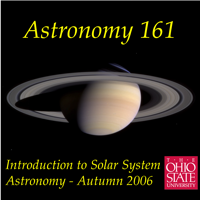
Astronomy 161 - Introduction to Solar System Astronomy Podcast
1) Astronomy 141 Podcast Teaser
A new podcast, Astronomy 141, Life in the Universe, is available for those interested in continuing an exploration of topics in modern astronomy.
2) Lecture 46: ExoPlanets - Planets around Other Stars
Are there planets around other stars? Are there Earth-like planets around other stars? Do any of those harbor life? Intelligent life? We'd like to know the answers to all of these questions, and in...Show More
3) Lecture 45: Is Pluto a Planet?
What is a planet? Is Pluto a planet? This lecture traces the debate on the nature of what it means to be a planet by taking an historical approach, looking at how the question has arisen with the d...Show More
4) Lecture 44: Comets
Comets are occasional visitors from the icy reaches of the outer Solar System. This lecture discusses the orbits, structure, and properties of comets, and introduces the "dirty snowball" model of a c...Show More
5) Lecture 43: Icy Worlds of the Outer Solar System
Beyond the orbit of Neptune is the realm of the icy worlds, ranging in size from Triton, the giant moon of Neptune, and the dwarf planets Pluto and Eris, all the way down to the nuclei of comets. Thi...Show More
6) Lecture 42: Asteroids and Meteoroids
Asteroids are the leftover rocky materials from the formation of the Solar System that reside mainly in a broad belt between the orbits of Mars and Jupiter. Meteoroids are fragments of asteroids or b...Show More
7) Lecture 41: Planetary Rings
All Jovian planets have rings. We are most familiar with the bright, spectacular rings of Saturn, but the other Jovian planets have rings systems around them. This lecture describes the different ri...Show More
8) Lecture 40: The Saturn System
Saturn is attended by a system of 56 known moons and bright, beautiful rings. The Moon system is the focus of our attention today. Saturn has one giant moon, Titan, which is the 2nd largest moon in ...Show More
9) Lecture 39: The Moons of Jupiter
Jupiter is surrounded by a solar system in miniature of 63 known moons. Most (59) are tiny, irregular bodies that are a combination of captured asteroids and comets. The 4 largest are the giant Galil...Show More
10) Lecture 38: Uranus and Neptune
Uranus and Neptune are the smallest and outermost of the 4 Jovian planets. While superficially similar to Jupiter and Saturn, there are substantial differences. Uranus and Neptune have smaller rocky...Show More